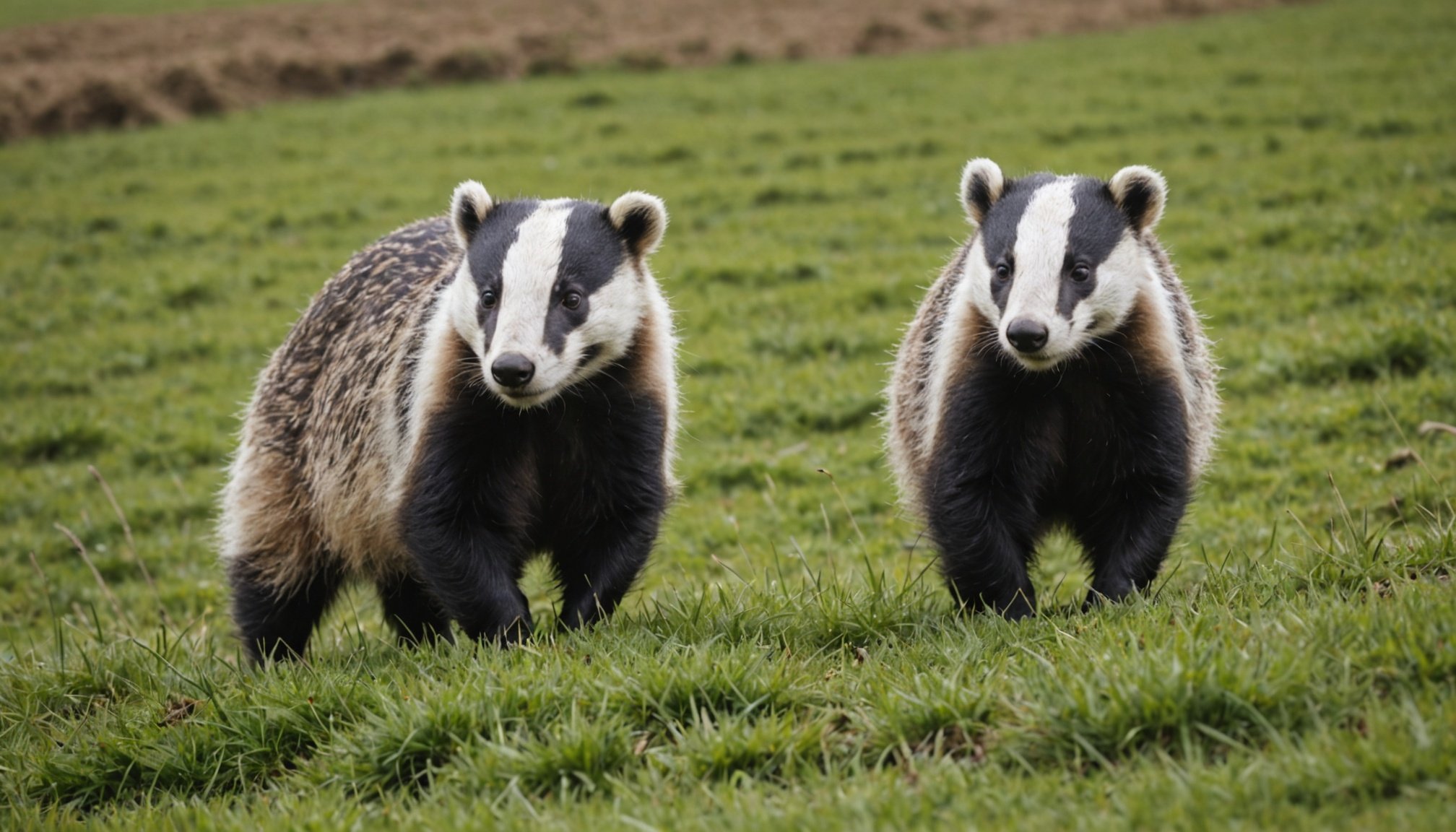Understanding the Challenges of Coexisting with Badgers
Attempting to coexist with badgers involves navigating complex interactions between badger behavior, livestock health, and maintaining ecological balance. Badgers play a significant role in the ecosystem. They help control insect populations and are crucial in soil aeration, thus contributing to biodiversity. However, their proximity to livestock often raises concerns, especially for farmers.
One primary concern is the transmission of diseases that can impact livestock health. Badgers are known carriers of bovine tuberculosis (bTB), a disease posing serious threats to cattle. The disease spreads through direct contact with contaminated materials, and infected livestock can suffer severe health issues, leading to economic losses for farmers.
This might interest you : Advancing wildlife welfare: how the latest uk hunting laws safeguard foxes and hares
These health threats highlight broader conflicts between agriculture and wildlife in the UK. Farmers worry about protecting their investments, while conservationists advocate for badger protection due to their ecological importance. Balancing these interests is a persistent challenge.
Adjusting farming practices might mitigate the disease risks. Enhancing biosecurity measures, like improving fencing to limit contact between livestock and badgers, is a potential solution. Collaborations between environmentalists and the farming community are crucial to develop strategies that bolster both livestock health and the ecological processes that badger behavior supports. Navigating these challenges is key to achieving a sustainable coexistence.
In the same genre : Revitalizing Traditional Orchards: UK Citizens Leading the Charge to Protect Unique Wildlife
Innovative Technology Solutions for Livestock Protection
The world of agriculture is evolving with technology in agriculture making livestock management more efficient. Farmers are increasingly adopting protective strategies to ensure their livestock’s well-being and productivity.
Smart Monitoring Systems
Smart monitoring systems are revolutionising livestock management. These technologies facilitate real-time monitoring of animals, using sensors and cameras to gather vital data. The information collected helps in health monitoring, enabling farmers to detect illnesses early and take necessary actions.
In the UK, relatable case studies illustrate the effectiveness of these systems. For example, farms using real-time monitoring have reported significant reductions in livestock loss and improved overall health. This is achieved through continuous data analysis, which provides insights into feeding patterns, movement, and behavioural changes.
Automated Fencing Solutions
Automated fencing is another key component of protective strategies. Modern mobile and electric fencing solutions act as reliable safeguards, especially in rural areas with wildlife like badgers. Automated systems are designed to respond to animal movements, providing a secure environment for the livestock. While these technologies offer high cost-effectiveness, the initial implementation can pose challenges in terms of terrain adaptation and maintenance.
Health Management Applications
Technological advancements are also influencing health management applications. Several apps and software solutions have been introduced for seamless livestock health tracking. Such tools allow farmers to analyse data, identify health trends, and address potential issues proactively. With successful implementation, farmers have noted improved livestock health, resulting in higher productivity and reduced veterinary costs. These apps offer a practical, technology-driven approach to monitoring and maintaining animal health.
Strategies for Ecological Balance and Sustainable Practices
Sustainable agriculture aims to integrate habitat management to support wildlife while protecting livestock. This approach requires balancing the needs of diverse species, maintaining ecological harmony, and promoting long-term agricultural productivity. Effective coexistence strategies are essential in areas where badgers may affect farming activities. By implementing habitat corridors and sanctuaries, farms can encourage wildlife movement and create safe zones, minimizing conflicts.
Reducing animal stress is another critical factor in successful ecological practices. Techniques include adjusting farming schedules to avoid peak badger activity, using deterrents that do not harm badgers, and employing non-invasive monitoring technologies. These practices not only foster peaceful coexistence but also maintain the welfare of farm animals, leading to healthier livestock and potentially greater yields.
Biodiversity plays a pivotal role in the resilience of agricultural systems. Encouraging a diverse range of plant and animal species can enhance soil quality, control pests naturally, and improve crop yields. Biodiverse farms are more adaptable to climate fluctuations, providing a sustainable foundation for future farming operations. By embracing biodiversity, farms can ensure their continued success and contribute positively to the environment. This integration of diverse species illustrates a commitment to both agricultural success and the health of the broader ecosystem.
Case Studies of Success in UK Farming Context
Understanding the nuances of UK farming through case studies offers insights into effective strategies. Each farm offers unique insights into implementing successful practices while integrating modern technologies.
Farm A: Innovative Approaches to Livestock Management
Farm A has pioneered in livestock management by deploying advanced technologies. Their strategies include using electronic tags and sensors to monitor livestock health, which has resulted in marked improvements. Enhancements include reduced illness rates and improved overall productivity. An intriguing aspect is their strategy for managing badger interactions. By utilizing detection systems, Farm A has successfully mitigated the risks associated with badger presence, ensuring a safer environment for their livestock. Farmers attest to the positive impacts, noting increased efficiency and improved animal welfare due to these technological interventions. One farmer observed, “Technology has reshaped our practices, bringing precision and peace of mind.”
Farm B: Balancing Tradition with Innovation
Farm B uniquely blends traditional methods with state-of-the-art technology. Traditional grazing systems are complemented by GPS tracking, allowing detailed monitoring of livestock location and movement. This mix of strategies has proven effective in managing badger presence, promoting livestock safety. Analysis reveals notable improvements in preventing interactions, demonstrating that embracing both old and new can yield significant benefits. Farmers express that this balance has maintained cultural practices while enhancing productivity, providing invaluable lessons in adaptive strategy development.
Expert Advice on Managing Badger Interactions
Engaging with agricultural experts can provide critical insights into effective badger management strategies. Many agricultural consultations emphasize an understanding of wildlife behaviour to mitigate potential conflicts. Experts recommend that farmers establish a proactive approach to badger interactions, focusing on both prevention and protection.
When seeking advice on livestock protection, farmers are encouraged to explore tailored management plans. Such plans typically include strategies like reinforcing fences, using deterrents, and habitat modification. Agricultural consultations often underline the importance of assessing the individual farm’s unique conditions and needs.
Farmers looking to delve deeper into wildlife management can access various resources to enhance their knowledge and skills. Attending workshops, connecting with local wildlife agencies, and joining agricultural networks offer opportunities for further education and professional growth. These avenues provide platforms for sharing experiences and solutions, fostering a community of support and innovation.
For those keen on expert opinions, connecting with experienced professionals through agricultural forums and consultative services can prove invaluable. These platforms often host discussions on the latest research and techniques, ensuring farmers are well-equipped to handle any challenges posed by badgers.
By leveraging these resources and expert advice, farmers can effectively manage badger interactions, safeguarding their livestock while respecting the local wildlife ecosystem.











